CROSS CURRENTS
Sisters of Notre Dame de Namur • Ohio Province

FOUR RIVERS, SEVEN CREEKS, ONE ROAD
SISTER REBECA SPIRES’ MINISTRY TO BRAZIL’S INDIGENOUS PEOPLES
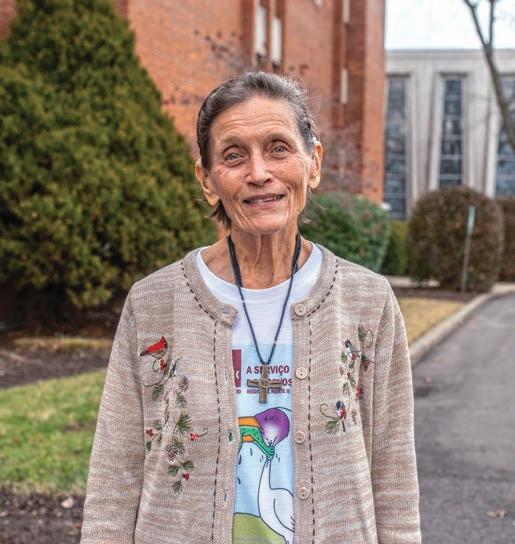
WINTER/SPRING 2023 VOLUME 19 ISSUE 1
CROSS CURRENTS
Winter/Spring 2023 | Vol. 19/Issue 1

Sisters of Notre Dame de Namur change lives by making known God’s goodness.

Throughout the world, we are committed to education. We take our stand with those living in poverty, especially women and children in the most abandoned places. Cross Currents is published two times a year for friends of the Sisters of Notre Dame de Namur by the Ohio Province Development Office.
We invite reader responses on the content of this publication or on the work of the Sisters of Notre Dame de Namur. Comments may be submitted to Kevin Manley, Director of Development, at kmanley@ohsnd.org.
Sisters of Notre Dame de Namur Ohio Province
701 E. Columbia Avenue
Cincinnati, OH 45215
513-761-7636 / 513-761-6159 (fax) www.sndohio.org
Leadership Team:
Sister Kathleen Harmon, SNDdeN, Provincial
Sister Donna Marie Jurick, SNDdeN
Sister Patricia Loome, SNDdeN
Publisher: Kevin Manley kmanley@ohsnd.org
513-679-8117
Writer: Joe Foley
Editor: Anne Brown Miller
Design: Jane Bobel
Photography:
Cover: Dyah Miller
Pages 5, 6 and 7: Artur Dias
Page 10 (top left): Courtesy of Encompass Theatre
All others by local and international Sisters and staff
COVER: Sister Rebeca Spires, SNDdeN, taken in Cincinnati, December 2022
SISTERS OF NOTRE DAME DE NAMUR
THE REACH OF NOTRE DAME
Geography — the Sisters of Notre Dame de Namur know geography about as well as anybody. Because they live it. They live it in our midwestern heartland, on our coasts, in the fields of Florida and in the deserts of Arizona. To make known the goodness of God, one cannot stand still. Words alone will not suffice. Presence is required.
And how this presence has expanded over the years! From Europe to the wharfs of Cincinnati 183 years ago. To Africa after that. To Latin America. The list goes on.
In this issue of Cross Currents you’ll see examples of this presence. Sometimes it’s Sisters traveling to faraway places, such as Sister Rebeca Spires, SNDdeN, on the rivers and creeks among the indigenous peoples of the Amazon. Sometimes it’s Sisters remaining in their own countries, such as Sister Margaret Inziani, SNDdeN, in her work to bring enlightenment and selfsufficiency to children who are deaf in Kenya’s Rift Valley. The Sisters go where others will not and do what others can not. As Saint Julie asks of them, they are having hearts as wide as the world. Mere geography doesn’t stand a chance!
KEVIN MANLEY Director of Development

WHEN A BIRD SINGS BACKWARD
If in any of the last 44 years along the jungled rivers of the Brazil-French Guiana frontier, you were to see an open, outboard, aluminum-bottomed boat making way, you would more than likely notice on the boat’s nicked and worn benches, among the many brown faces set against the wind, one fair one, and it would be Sister Rebeca Spires, SNDdeN. CONTINUED ON
You would see her in the equatorial rivers like inland seas where the sun blazes top-down and sideways off the water, and in the narrow rain-drenched creeks with alligators sizing up the passing boat.
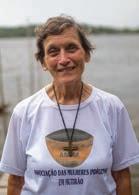
These are long journeys, five hours if not more, and Sister Rebeca knows them well. She knows the grandparents, parents and children in the passing, stilt-raised villages. She knows the surfacing fish that nose to tail are longer than the boat. She knows the push and pull of the tides that determine when and where you go.
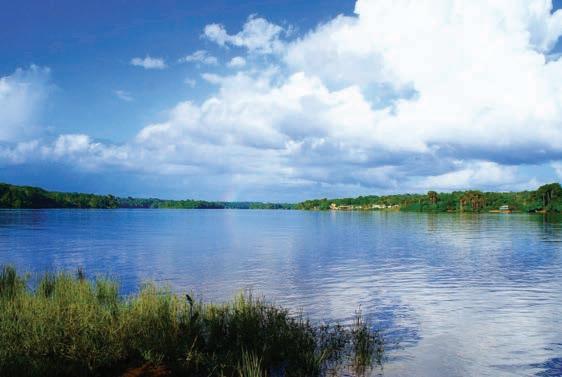
3 CROSS CURRENTS
4
PAGE
The jungled Oiapoque River (pictured) meanders along the Brazil-French Guiana frontier in Amapá, Brazil.
SISTERS OF NOTRE DAME DE NAMUR
It’s a place where time to a destination isn’t so much measured in distance as in the height of the tide and an engine’s horsepower.
All told, Sister Rebeca has worked among four indigenous peoples settled in scores of villages on four rivers, seven creeks and one road. It’s a place where time to a destination isn’t so much measured in distance as in the height of the tide and an engine’s horsepower. Some villages are the size of a town, some only a few families. In the rainy season, when it’s ‘big water’ as Sister Rebeca calls it, a boat can navigate among the houses. In the dry season, logs lay as boardwalks over the spongy ground. In either season, Sister Rebeca continues her life’s ministry.
Sister Rebeca is well known for her work phoneticizing indigenous languages. It was the beginning of her work in the Amazon, and when she was a young woman. But it has not been her only work, nor does she consider it her most important. But more on that in a moment.
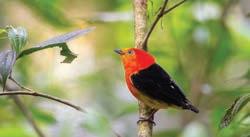
For now, see her as that young woman — born in temperate Ohio, a school teacher — transplanted into jungle and heat and water. She had come to Brazil in 1970 to work with Sister of Notre Dame de Namur Dorothy Stang. They were in the state of Pará. Then, and because she was a teacher, she was invited north where there was much discontent with government-sponsored education.
“The chief of the village,” says Sister Rebeca, “he said, ‘These teachers that come in from the government, and teach in the schools, don’t respect my children. They say they’re dumb … They don’t get it that they are speaking a language [Portuguese] and my children don’t understand what they’re saying. So how can they learn to read it if they don’t understand? And so could somebody come in? Could you get somebody to put our language in writing so we can have our own books?’ And that’s what I was invited to do. So to do that, of course, I lived with them. And I did everything they did with them.”
4
Oiapoque is in the state of Amapá in northern Brazil.
The crimson-hooded manakin (Pipra Aurelia), pictured here, is a species of bird that dwells along tropical tributaries, including the Oiapoque River in Amapá, Brazil.
The village was Espirito Santo, a Karipuna village and an hours-long boat ride from the nearest municipality. And to that municipality — Oiapoque — there was at the time no road. Instead, the Brazilian Air Force flew in supplies on amphibious World War II-era Douglas C-47s, landing and taking off on the Oyapock River. And on such a C-47 Sister Rebeca hitched a ride. Then, at Oiapoque, where she is based to this day, she traveled by canoe to Espirito Santo.
There was only one house in Espirito Santo having four walls, and that’s the house the village gave her. All the other houses had but one wall, always positioned to block the rain. And it rained all the time, so much so that the
houses, including Sister Rebeca’s, rested on stilts. Nowhere in the village was there electricity. And it was from here, Sister Rebeca’s teaching of the people, and their teaching of her, began.
“First I had to learn to talk,” she says. “So I went to the fields with them. They taught me in the cassava fields, in the sweet potato fields. Then, in the evening, you sat around the fire or around the kerosene lamp on the table, and told stories. So it was not hard to learn.”
Sister Rebeca as well witnessed the villagers’ daily lives, their spirituality, their means of survival. She learned that in times of ‘big water’, the villagers shifted their diet from fish to game, because as the water rose it drove animals onto smaller and smaller islands, where they could be hunted. Conversely, when the water was down, fish became concentrated in the narrowing rivers and creeks. She saw fish so long they had to be harpooned, and alligators hunted with those same harpoons.
She heard stories of what nature had to say, if only a person listened, such as when a bird sings backward. “Do you think that’s superstitious?” asked a villager. She heard stories of what nature had to say, if only a person listened, such as when a bird sings backward.
“No,” said Sister Rebeca. “It’s what you have learned of God through nature.”
In the little wooden house
Sister Rebeca remained in Espirito Santo two years, living in the ‘little wooden house,’ as she calls it. One of the walls didn’t come to the house’s corner, so that from the back of the house she could reach to a graviola tree, for its large spikey fruit.
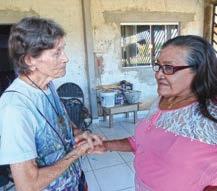
In the middle of the one room sat a table, and nearly every day for those two years 10 young villagers,
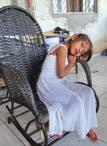
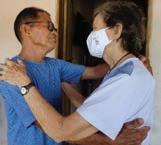
5 CROSS CURRENTS
CONTINUED ON PAGE 6
Sister Rebeca’s friends are members of the Aikewar people, an indigenous group previously used as guides to search for guerrilla fighters in the forest. “These people have been through so much and are so good …,” Sister Rebeca says.
“So to do that, of course, I lived with them. And I did everything they did with them.”
—Sister Rebeca
SISTERS OF NOTRE DAME DE NAMUR
ones who had learned Portuguese, sat with Sister Rebeca. Together, they teased, coerced and corralled an amalgamated and unwritten language of indigenous words, French Creole, Portuguese and even African Bantu into the rules and phonetics of Latin letters. In some cases, they imported words that to date had no reason to exist.
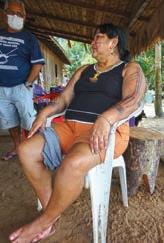
“They didn’t have a word for windows,” says Sister Rebeca, “because they didn’t have windows in their houses.”
Once the language was coupled to an alphabet, the village had a means to translate books into their own language, and to write their own books, allowing for effective education, which was the first objective. It also, according to Sister Rebeca, provided a tool whereby people in the village and other villages could collaborate for mutual benefit, such as in cooperatives and commerce. Long term, the alphabet has enabled organizing and participation in Brazil’s democracy, abilities that have over the years, as commercial interests edge closer, become vital to the villages’ continued way of life.
This, though, was long in the future as Sister Rebeca and the 10 young people worked in the little wooden house. Sometimes, Sister Rebeca recalls, they broke from work, went to where the wall ended, and where the graviola tree rose closely. They’d eat the fruit, look into the jungle, and just talk.
“It was very healthy, free and honest,” she says.
A bigger picture
Since those first two years, Sister Rebeca has traveled to all the villages along the rivers and the one road. She assists with the alphabet still, and with advocacy, and with religious activities and formation. Then, once again, she is out on the water. Then, once again, she is out on the water.
But a lot is changing.
Technology has allowed in outside customs, some not helpful. A gold rush just over the Oyapock has brought new people to the area, and has drawn villagers
away. Mining and timber interests move ever closer. Whereas in her younger years Sister Rebeca worked to better integrate indigenous peoples into the wider world, now she worries such integration, if not done with prudence, will endanger them. And this is where her work now lies.
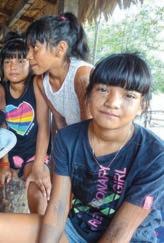
“This means more than the alphabet to me,” she says.
She acknowledges the dangers from without – the loggers and miners, the changes in rainfall, the antipathy of government. But she worries too about changes from within. There is electricity now in many of the villages, and there are cell phones and televisions. The houses have four walls, and doors that lock. And there is the concept — and the possession of — money. All of these can be seen as good, but together and combined with
6
These girls and woman, adorned with genipapo drawings, are members of the Krikatejê people in Pará, Brazil.
“[Indigenous peoples] …are very close to nature …They know God in nature. They share everything. So there's a basic goodness there.”
—Sister Rebeca
new standards of behavior infiltrating from the larger world, they represent a challenge to the villages’ traditional way of life.
Gone are the days, says Sister Rebeca, when wealth was measured in alligators, fish, water turtles and things you could hunt. “Money just wasn’t part of it,” she says. “Now, some have more, some have less. And that makes a difference.”
In the face of such change, Sister Rebeca meets with chiefs and is invited to chiefs’ councils. She urges unity in the face of outside threats. The villages have a right to their territory, she says, but they also have a right to their customs.


“Maintain the culture alive,” she tells them. “Don’t go backward, but you have to bring with you that which is of great value.
Still on the water
At 80, Sister Rebeca still plies the waterways. She climbs in boats and balances on logs. She often sleeps in a hammock. Her age, and perhaps more importantly, her longevity in the work, have earned her respect in all the villages. Her opinion is sought, and valued.
“I’m like an old grandmother figure. I’ve come to this venerable old age, and that’s very respected,” she says. “But it brings with it more responsibility because I know I’m being heard.”
Sometimes in the boats, the jungle passing, the smell of the water, among the trees she loves — she thinks of trips past, and years past. She thinks of her friend Dorothy Stang, SNDdeN and when they would sit side by side on a tree root deep in the forest, and pray. She thinks of the 10 young people at work in the little wooden house, and of the graviola tree that handed them lunch. She thinks of canoe trips extending into the night, at times in the rain, and of the eyes of the animals watching.
—Sister Rebeca
“If you let go what your ancestors taught you,” she says, “you will not be Indians anymore. And those things they taught you, that’s what Jesus teaches you. To share what you have. The working together. The deciding together. To love one another. To respect one another. To help one another. We don’t look for enemies; we look for brothers and sisters.
“Don’t lose yourself!” she says.
“I think in images, like films,” she says. “I have a head full, and I’ll probably be playing those films in my head forever.”
7 CROSS CURRENTS
“Maintain the culture alive.”
NEWSBRIEFS
SISTERS OF NOTRE DAME OPEN SCHOOL FOR THE DEAF
The Bishop Korir Memorial Secondary School for Differently Abled, owned by the Diocese of Eldoret in Kenya and administered by Sisters of Notre Dame de Namur, opened in January. The school is the only secondary school in Kenya’s Rift Valley to serve students who are deaf. Previously, such students ended their education at the primary
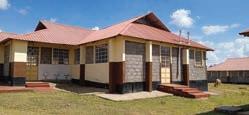
school level. Sister Margaret Inziani, SNDdeN, will lead the school.
“Disability is not a lack of ability,” says Sister Margaret. “We are here to help them [the students] become somebody, and to become a good person in their community and in their family.”
Eventually, children who are blind will attend, as will children with
ADDRESSING PLASTIC OVERUSE

A group of Sisters wrote their own prescription for reducing single-use plastics in the Mount Notre Dame Health Center.
Sister Pat Rooks, SNDdeN, a long-time advocate of respecting God’s creation, and fellow assisted living residents, challenged the Center’s practice of dispensing medications one pill at a time in pre-packaged plastic envelopes. A letter cosigned by 24 residents encouraged administration to negotiate sustainable alternatives with the Center’s pharmaceutical provider.
other disabilities. Importantly, children not having disabilities will also be admitted. They will assist the other students, such as in the dormitories and dining hall, and will, through their presence, break down that divide between the able-bodied and those more limited, to the point, says Sister Margaret, “that they will know one another as brothers and sisters.”
When the vendor was unable to accommodate the Sisters’ request, the Center offered residents an option to order medications from a different pharmacy.
Justice, Peace and Care of Creation Director Teresa Phillips affirmed the outcome: “The Center is the Sisters’ home. They have a right to choose what enters their living space,” she said.
PRAYER COMMUNITY CARDS
“As vowed religious women, we take Pope Francis’ Laudato Si plea seriously and are dedicated to what we can do to contribute to building a better future for our earth and its people.”
—From the residents’ letter
8
SISTERS OF NOTRE DAME DE NAMUR
The Bishop Korir Memorial Secondary School for Differently Abled
IN SEARCH OF CLIMATE JUSTICE
Sister Claudine Dumbi, SNDdeN, center, from the Congo-Kinshasa Province, attended the United Nations’ International Meeting on Climate Change (COP27) last November. Administrators at Catholic University in Congo, where Sister Claudine is a professor of agriculture and a researcher on ecology and the environment, sent her to represent the university at the global event.
The latest conference concluded without universal commitment to limit global temperature increases and bolster climate resilience.
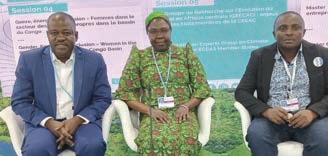
ADVENT IN KENYA
A Jesse Tree — adorned in symbols designed by novices — extended its branches from Kenya to the United States in Advent greetings sent by Sister Thérèse DelGenio, SNDdeN. “It has been a delight to listen to each novice (pictured) show the symbol she designed [depicting] Jesus’ ancestors …,” said Sister Thérèse.
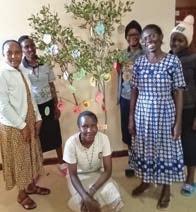
FROM LEFT TO RIGHT: Sister Lucy Fusemei, SNDdeN (novice director), and Sisters Naom, Vivian, Anne, Fanciscar and Mary (novices).
of Notre
CHRISTMAS HOMECOMING
Sisters of Notre Dame de Namur who shared time serving the poor in Brazil recently reunited at the Ohio Province.
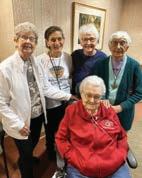
LIBRETTO OF A LIFE WELL-LIVED
Angel of the Amazon, an operatic presentation of the life and mission of Sister Dorothy Stang, SNDdeN, was presented in November 2022 at the Sheen Center for Thought and Culture in New York City.
PICTURED HERE (ALONG WITH FRIENDS) are Sisters of Notre Dame de Namur who attended Angel of Amazon: Ohio Provincial Kathleen Harmon (back row, center); Kumiko Azuma (back row, right); Mary Alice McCabe (front row, left); and Maria Delaney (front row, right).
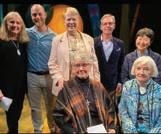
9 CROSS CURRENTS
FROM LEFT TO RIGHT: Sisters
Dame de Namur Judi Clemens, Rebeca Spires, Jo Anne Depweg and Ani Caroline Wihby. CENTER: Sister Joan Krimm
WE WILL ALWAYS REMEMBER
We are mindful that we stand on the shoulders of those who have come before us. For complete obituaries, please visit sndohio.org

SISTER ANTOINETTE BERGEN, SNDdeN
Formerly Anthony St. John
March 7, 1930–August 20, 2022
Known as a patient listener, Sister Antoinette (“Toni”) did more than provide direct service to people trapped in poverty. She actively advocated for systemic change.
Sister Toni taught in parish schools before pursuing licensure as a social worker. Her call led Sister Toni to Chicago’s Marillac House, a Daughters of Charity-sponsored ministry. There, Sister Toni served as Director, Family Services; as caseworker for neglected and abused children; and as a participant in community development.
In addition to hands-on ministry, Sister Toni devoted time to legislative advocacy, commenting she was privileged to serve Christ in “the materially poor of God’s people.”
SISTER PEGGY LINAHAN, SNDdeN
Formerly Michael
February 17, 1926–September 14, 2022
Sister Peggy Linahan, initially a primary school teacher, was a pioneer in online learning.




During the 1960–1970s, she helped develop a television-based educational curriculum for one New York diocese and produced a video series about state history at the request of another. During summers, Sister Peggy studied at Syracuse University, earning master’s degrees in Radio and Television and Education.
She taught Communication Arts and Religion and established a school-based production studio that inspired high school students to consider a career in electronic media. Sister Peggy never truly ‘retired’ and entered a new ministry at age 85 (Hour Children, a provider of services to incarcerated and formerly incarcerated women).
SISTER EILEEN SWEENEY,

Formerly Mary Regina
December 25, 1924–November 2, 2022
Sister Eileen Marie Sweeney came home from her very first day of school and announced to her mother, “When I grow up, I’m going to be a Sister and a teacher.” She never wavered in her decision.
Sister Eileen grew up in Chester, PA, and first became acquainted with the Sisters of Notre Dame de Namur in high school. “The Sisters impressed me with their care and individual concern for each student, as well as their professionalism.”
Sister Eileen taught foreign languages to high school students, served as secondary principal and held leadership roles with the Maryland Province.
SISTER MARIAN SCHAECHTEL, SNDdeN
Formerly Marian James
November 7, 1937–January 21, 2023
Sister Marian Schaechtel was the beloved only child of Russian and Romanian immigrants. Her parents lovingly conveyed their faith to Marian, ensuring that she received a Catholic education. The Sisters who taught Marian in grade school and high school impressed her: She felt called to be a Sister at a very young age.
On August 14, 1955, Marian and 35 other young women entered the Sisters of Notre Dame de Namur at Illchester, MD, and prepared for a teaching ministry. “I never looked back,” Sister Marian recalled. Sister Marian, who also served in leadership with the Maryland Province, brought her dry sense of humor, quiet presence and a deep spirit of prayer to each person she met.
10
SISTERS OF NOTRE DAME DE NAMUR
“A simple soul is affectionate and attentive to the needs of others.”
—St. Julie Billiart
THE GIFT OF YOUR FRIENDSHIP
Our Sisters sincerely appreciate the gift of your friendship, and they regularly include you and your family in their prayers. Through the years you have helped us provide quality care for our retired Sisters; supported our educational work at home and abroad; and, assisted The Clean Water for Life Program that helps save lives in Notre Dame maternity clinics and schools in Africa. Much of this support has come from friends like you who, after taking care of their loved ones, have included a gift to the Sisters in their estate plans.
It can be concerning, though, when costs continue to rise, and investments have declined. With these and other factors in mind, now is a good time to evaluate your preparations so you can make any modifications needed. There are also some “smart” ways to continue assisting our mission that can provide both tax savings and tax benefits, all while furthering the Sisters’ work.
• Giving appreciated stock that you’ve owned more than one year to the Sisters entitles you to an income tax charitable deduction (if you itemize) for the full value of the shares on the date of the gift, completely avoiding the capital gains tax. You can even retain payments for life from your gifts if you use your appreciated securities to fund a life income plan.
• Another option is to use the proceeds from the sale of shares that have dropped in value to make a charitable gift to the Sisters, so you can claim both a capital loss deduction and, if you itemize, an income tax charitable deduction
• For those who are 70½ or older, you can make qualified charitable distributions (QCDs) to the Sisters from your IRA. A maximum of $100,000 per year
can be given. When you give directly from your IRA, instead of withdrawing these funds, you won’t increase your adjusted gross income or subject your Social Security income to more taxes. QCDs are a win-win!
I hope these ideas are helpful as you prayerfully consider your current and future support of the Sisters. I am available to discuss charitable giving ideas with you. Please contact me at 513-679-8106 or khadden@ohsnd.org for more information or if I can assist you in the charitable aspects of your plans.
KAREN HADDEN Associate Development Director
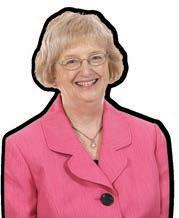
513-679-8106
khadden@ohsnd.org
11 CROSS CURRENTS
Address Service Requested
LET'S DO LUNCH!
LET’S DO LUNCH!
We invite you to our 20th annual Partners in Action fundraising luncheon for friends of the Sisters of Notre Dame de Namur who live in the Greater Cincinnati area. Please join us as we gather on May 4 at the Cintas Center on the Xavier University campus.
We invite you to our 20th annual Partners in Action fundraising luncheon for friends of the Sisters of Notre Dame de Namur who live in the Greater Cincinnati area. Please join us as we gather on May 4 at the Cintas Center on the Xavier University campus. This mission-based luncheon program begins promptly at noon and ends precisely at 1:00 p.m. The program will emphasize the educational work and mission of the Sisters of Notre Dame de Namur in a variety of ministries.
FOLLOW US ON SOCIAL MEDIA + THE WEB


facebook.com/SistersOfNotreDamedeNamurOhio
This mission-based luncheon program begins promptly at noon and ends precisely at 1:00 p.m. The program will emphasize the educational work and mission of the Sisters of Notre Dame de Namur in a variety of ministries.
youtube.com/c/SistersofNotreDamedeNamur
Reservations are required by contacting Karen Hadden at 513-679-8106 or khadden@ohsnd.org.
twitter.com/SNDdeNOhio
ABOVE
Top Row Left to Right:
Sisters Mary Ellen Carinato, Ann Fanella and Colette Quinn
Reservations are required by contacting Karen Hadden at 513-679-8106 or khadden@ohsnd.org.
Middle Row L eft to R ight:
Sisters Carol Defiore, Rita Sturwold and Marie Kelly
Bottom Row L eft to R ight:
Sisters Mary Ann Zwijack, Lois Ann Meyer and Marilyn Kerber
BUY GOOD. DO GOOD. LIVE THE GOOD.
Live The Good New tee shirts purchased for Live
CALENDAR OF EVENTS
The Good volunteers embody action for justice and engender care for God’s creation.
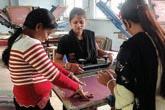

Saturday, March 19, 2022 Volunteer Opportunity 9:00 a.m. to 11:00 a.m.
Wednesday, May 11, 2022
instagram.com/sndohio
linkedin.com/company/sisters-of-notre-dame-de-namur


Sunday, June 5, 2022
Crafted by Joyya in West Bengal, India, these 100% organic cotton shirts are handmade by women living in poverty and vulnerable to
Partners in Action Luncheon Cintas Center at Xavier University Cincinnati, OH 12:00 p.m. to 1:00 p.m.
Saturday, May 7, 2022
Live the Good Volunteer Opportunity Mission of Mary Dayton, OH 10:00 a.m. to 12:00 p.m.



Thursday, August 4, 2022
Notre Dame High School – Chicago: Our Lady of the Window Society Mass and Luncheon Inducting the Classes of 70, 71 & 72 & Honoring Classes 1941 through 1969 Crowne Plaza Chicago – Northbrook Northbrook, IL
the sex trafficking industry. “Cotton is responsibly sourced, and the use of water-based inks ensures workers’ and customers’ protection from toxic chemicals,” says Holly Schlaack, Director of Volunteer Engagement. “Such commitment to the environment aligns with the Sisters’ pledge to Pope Francis’ Laudato Si’ call,” Holly adds.
Live the Good Volunteers Appreciation Day Mt. Notre Dame Convent — Amiens Hall Cincinnati, OH 6:00 p.m. to 7:30 p.m.
Gather at 10:30 a.m., Mass at 11:00 a.m. and Luncheon at 12:15 p.m.
VISIT OUR WEBSITE WWW.SNDOHIO.ORG
VISIT OUR WEBSITE WWW.SNDOHIO.ORG FOR MORE DETAILS AND TO REGISTER
the Good
Live
SISTERS OF NOTRE DAME DE NAMUR SISTERS OF NOTRE DAME DE NAMUR
THURSDAY 4THMAY •2023 PARTNERS IN ACTION LUNCHEON
PARTNERS IN ACTION LUNCHEON
ABOVE: Apparel manufacturer Joyya provides living wages to its employees as well as access to health care, education and job training.


































